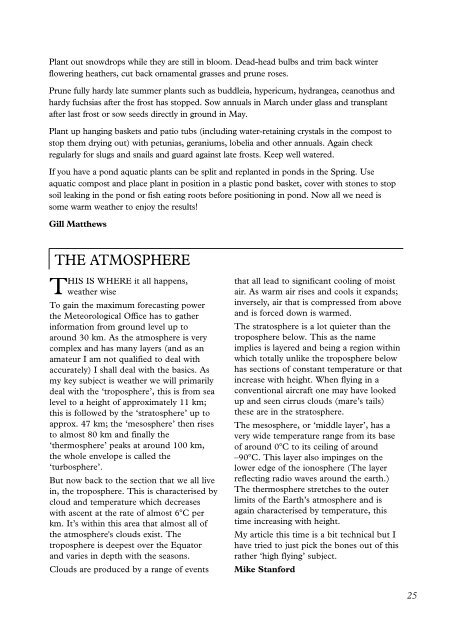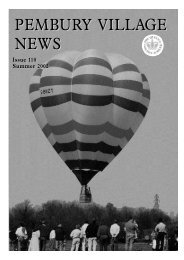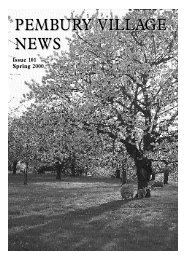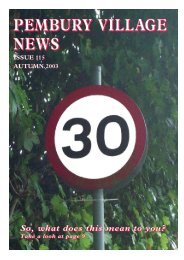Issue 105 - the Pembury Village Website
Issue 105 - the Pembury Village Website
Issue 105 - the Pembury Village Website
- No tags were found...
Create successful ePaper yourself
Turn your PDF publications into a flip-book with our unique Google optimized e-Paper software.
Plant out snowdrops while <strong>the</strong>y are still in bloom. Dead-head bulbs and trim back winterflowering hea<strong>the</strong>rs, cut back ornamental grasses and prune roses.Prune fully hardy late summer plants such as buddleia, hypericum, hydrangea, ceanothus andhardy fuchsias after <strong>the</strong> frost has stopped. Sow annuals in March under glass and transplantafter last frost or sow seeds directly in ground in May.Plant up hanging baskets and patio tubs (including water-retaining crystals in <strong>the</strong> compost tostop <strong>the</strong>m drying out) with petunias, geraniums, lobelia and o<strong>the</strong>r annuals. Again checkregularly for slugs and snails and guard against late frosts. Keep well watered.If you have a pond aquatic plants can be split and replanted in ponds in <strong>the</strong> Spring. Useaquatic compost and place plant in position in a plastic pond basket, cover with stones to stopsoil leaking in <strong>the</strong> pond or fish eating roots before positioning in pond. Now all we need issome warm wea<strong>the</strong>r to enjoy <strong>the</strong> results!Gill Mat<strong>the</strong>wsTHE ATMOSPHERETHIS IS WHERE it all happens,wea<strong>the</strong>r wiseTo gain <strong>the</strong> maximum forecasting power<strong>the</strong> Meteorological Office has to ga<strong>the</strong>rinformation from ground level up toaround 30 km. As <strong>the</strong> atmosphere is verycomplex and has many layers (and as anamateur I am not qualified to deal withaccurately) I shall deal with <strong>the</strong> basics. Asmy key subject is wea<strong>the</strong>r we will primarilydeal with <strong>the</strong> ‘troposphere’, this is from sealevel to a height of approximately 11 km;this is followed by <strong>the</strong> ‘stratosphere’ up toapprox. 47 km; <strong>the</strong> ‘mesosphere’ <strong>the</strong>n risesto almost 80 km and finally <strong>the</strong>‘<strong>the</strong>rmosphere’ peaks at around 100 km,<strong>the</strong> whole envelope is called <strong>the</strong>‘turbosphere’.But now back to <strong>the</strong> section that we all livein, <strong>the</strong> troposphere. This is characterised bycloud and temperature which decreaseswith ascent at <strong>the</strong> rate of almost 6C perkm. It’s within this area that almost all of<strong>the</strong> atmosphere's clouds exist. Thetroposphere is deepest over <strong>the</strong> Equatorand varies in depth with <strong>the</strong> seasons.Clouds are produced by a range of eventsthat all lead to significant cooling of moistair. As warm air rises and cools it expands;inversely, air that is compressed from aboveand is forced down is warmed.The stratosphere is a lot quieter than <strong>the</strong>troposphere below. This as <strong>the</strong> nameimplies is layered and being a region withinwhich totally unlike <strong>the</strong> troposphere belowhas sections of constant temperature or thatincrease with height. When flying in aconventional aircraft one may have lookedup and seen cirrus clouds (mare’s tails)<strong>the</strong>se are in <strong>the</strong> stratosphere.The mesosphere, or ‘middle layer’, has avery wide temperature range from its baseof around 0C to its ceiling of around–90C. This layer also impinges on <strong>the</strong>lower edge of <strong>the</strong> ionosphere (The layerreflecting radio waves around <strong>the</strong> earth.)The <strong>the</strong>rmosphere stretches to <strong>the</strong> outerlimits of <strong>the</strong> Earth’s atmosphere and isagain characterised by temperature, thistime increasing with height.My article this time is a bit technical but Ihave tried to just pick <strong>the</strong> bones out of thisra<strong>the</strong>r ‘high flying’ subject.Mike Stanford25
















